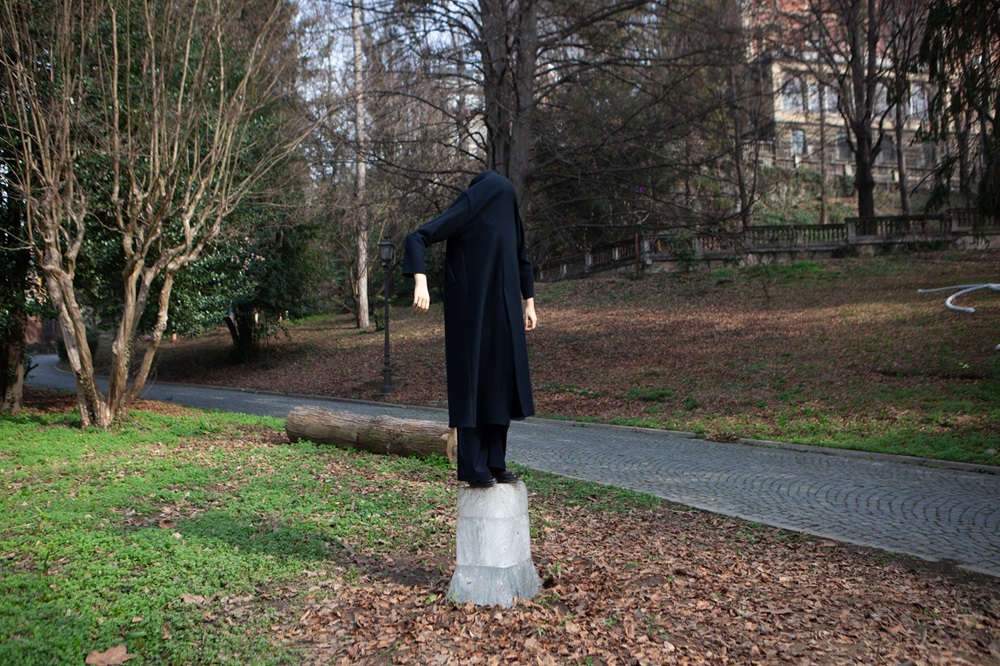In the spaces of Recontemporary, at the foot of Turin ’s Mole Antonelliana, an exhibition-workshop curated by Lisa Parola and Tea Taramino will be offered from March 7 to 28, 2024, to investigate the issues of the presence of women’s history in public space and its narrative. In other words: are women sufficiently represented in the monuments that adorn our squares? Irene Pittatore ’s works will be presented to the public as tools for reflection with respect to the themes of the research and will be the starting point for workshops and meetings open to schools, universities and a diverse audience.
The exhibition, which was created as an itinerant project, includes posters, a banner, videos and photographs of artistic performances that will be used each time as the incipit of meetings with experts and activists. Monumenta Italia, this is the title of the artistic project to raise awareness and spread awareness, aims to involve the public in reflecting on the inadequacy of women’s monuments. Indeed, it is an opportunity to reflect on the monumental city, memory and heritage in the context of women’s history. The site of Monumenta Italia has its first base in Turin and was created to operate nationwide and bring together the skills of female cultural and art workers accompanied by a series of works conceived by artist Irene Pittatore, based on the research project of the Centro Studi e Documentazione Pensiero Femminile APS Monumental Forgetting, aimed at surveying the presence of monuments dedicated to historical female figures in Piedmontese cities and municipalities.
Never before, the organizers argue, do we need to return to thinking about the idea of public heritage in relation to women’s history and the very concept of monumentality. Indeed, artistic heritage in public space is still and only male. Women’s statues have no name, do not document a fact and are most often presented as archetypes, symbols, muses: prosperity, homeland, justice, often represented reclining or kneeling at the hero’s feet, are symbols, almost never women protagonists of facts or actions. From these premises, Monumenta Italia interrogates, investigates, researches with the intention of challenging the idea of monumentality in favor of an in-depth reflection on a public presence of women.
Part of the data taken up by Monumenta Italia arise from Monumental Forgetting (2018), a research project of the Centro Studi e Documentazione Pensiero Femminile APS aimed at census the presence of monuments dedicated to historical figures of women in Piedmontese and Italian cities and municipalities. The census was supported by the Piedmont Regional Council and the Piedmont Council of Women Voters in 2018. This census revealed unequivocal data: in Turin, Piedmont’s provincial capitals, and the 1088 municipalities with more than 5,000 inhabitants, the number of monuments dedicated to women is extremely low, if at all.
Born in Turin on 1979 Irene Pittatore is a visual artist and performer whose work explores possible forms of sisterhood and solidarity to counteract the isolation and precarity that accompany artistic and social work in our time. She uses multiple visual, narrative and participatory tools to create works that reflect on marginalization, discrimination and their symptoms, from a feminist and intersectional perspective.
Her projects, dedicated to gender-based violence (I loved her too much and I shot her), diversity and inclusion (You as me / In the shoes of others), housing emergency (Homeless heroines), body positivity (Floating portraits), and remote photography (From a distance), are developed in relation to collaborations with museums, festivals, universities, and nonprofit organizations, including Politecnico di Torino, Università degli Studi di Torino, Fondazione Sandretto Re Rebaudengo (Turin), Camera - Centro Italiano per la Fotografia (Turin), Museo di Fotografia Contemporanea (Cinisello Balsamo, Milan), Es Baluard Museu d’Art Modern i Contemporani (Palma de Mallorca), Capacete (Rio de Janeiro and São Paulo), Festival Jeu de l’Oie (MUCEM and Aix- Marseille Universitè), Biennale des Jeunes Créateurs d’Europe et de la Méditerranée, 12 Bienal de la Habana OFF.
 |
| Are women adequately represented in public monuments? In Turin, an exhibition on the subject |
Warning: the translation into English of the original Italian article was created using automatic tools. We undertake to review all articles, but we do not guarantee the total absence of inaccuracies in the translation due to the program. You can find the original by clicking on the ITA button. If you find any mistake,please contact us.